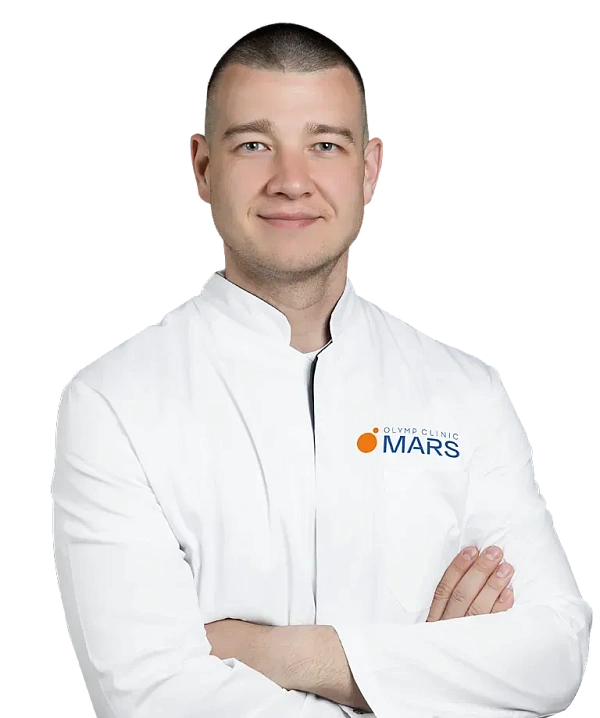PRP therapy for sports injuries
One of the effective non—surgical methods of treating sports injuries is PRP therapy with its own plasma.

Ligament tears, tendon inflammation, and muscle damage require effective treatments for rapid recovery. PRP therapy is one such method that is used in acute and chronic conditions.
The patient's blood is processed in a centrifuge to produce plasma, which is then injected into the damaged area. Enriched with growth factors, its own plasma triggers a powerful process of natural recovery, healing and strengthening of the tissues of the affected area. PRP therapy is widely used in the treatment of injuries to joints, tendons and muscles, which makes it especially popular among athletes. As a result of treatment, the rehabilitation period after an injury is shortened, inflammation, pain and swelling are reduced.
Clinical blood test Radiography of the affected area Magnetic resonance imaging (MRI) Consultation with a therapist and specialized specialists, such as an orthopedic traumatologist
At the initial consultation, the doctor conducts a clinical examination and evaluates the volume of movements. After that, the patient's blood is taken into a special test tube. The blood is processed in a centrifuge, where plasma enriched with platelets is separated. The resulting plasma is injected into the affected area. After the procedure, the patient can immediately return to the usual schedule, following the doctor's recommendations.
Centrifuges for blood processing and plasma production Special tubes for blood collection and treatment Injection systems for plasma injection
After PRP therapy, pain relief and improvement of motor functions occur within 3-4 weeks. The duration of the effect lasts up to six months. Repeated courses of therapy may be recommended to maintain the achieved results. Physiotherapy and physical therapy are also possible during the rehabilitation period.
Benefits
Minimal risk of rejection
Prokinetic plasma is extracted from the patient's own blood, the probability of rejection or allergic reactions is minimal.
No risk of infections
The PRP procedure eliminates the risk of transmission of infections.
Less recovery time
PRP therapy helps to reduce recovery time after sports injuries.
Frequently Asked Questions
How long does the course of treatment last?
When can I expect improvement after starting treatment?
Is it possible to combine this treatment with other therapies?
Didn't find an answer to your question?
You can describe your problem in detail and ask a question to the doctor. He will answer you and help you find a solution
Врачи
Смотреть всех врачейCandidate of Medical Sciences. Orthopedic Trauma Physician, Senior Physician.
Candidate of Medical Sciences. Orthopedic trauma surgeon, senior physician.
Candidate of Medical Sciences. A surgeon and an orthopedic traumatologist. Head of the Department of General Orthopedics.
Expected effect
Stimulation of tissue healing
Prokinetic plasma contains high concentrations of platelets, which are rich in growth factors. These factors contribute to accelerated healing of damaged tissues such as tendons, ligaments and muscles.
Pain Reduction
Growth factors in the prokinetic plasma may have analgesic properties, which reduces pain in the area of injury.
Reducing inflammation
Prokinetic plasma helps to relieve inflammation in the injury area, which contributes to faster recovery.
Improving the quality of fabrics
Stronger and resistant to repeated tissue damage.
Similar referral activities
Arthroscopy of the ankle joint
Ankle arthroscopy is a minimally invasive surgical procedure used to diagnose and treat various diseases and injuries of the ankle joint.
Arthroscopy of the knee joint
Knee arthroscopy is a minimally invasive surgical procedure for the diagnosis and treatment of injuries and diseases of the knee joint. It allows examining the joint for damage and eliminating the identified defects.
Arthroscopy of the elbow joint
Arthroscopy of the elbow joint is a minimally invasive surgical intervention that allows for accurate diagnosis and simultaneous treatment of joint injuries.
Arthrodesis of the joints of the fingers of the hand
The destruction of the joints of the fingers of the hand is accompanied by pronounced pain and impaired functions. Arthrodesis is a surgical intervention in which the affected joint is completely immobilized, which relieves pain and progression of inflammation.
Arthroscopic revision of the cystic joint
The condition of the wrist joints determines the functioning of the hand. Arthroscopic revision is a minimally invasive diagnostic procedure that assesses the condition of the joint tissues, which is necessary for planning subsequent treatment.
Arthroscopy of the shoulder joint
Arthroscopy of the shoulder joint is a minimally invasive surgical procedure designed to diagnose and treat various diseases and injuries of the shoulder joint.


